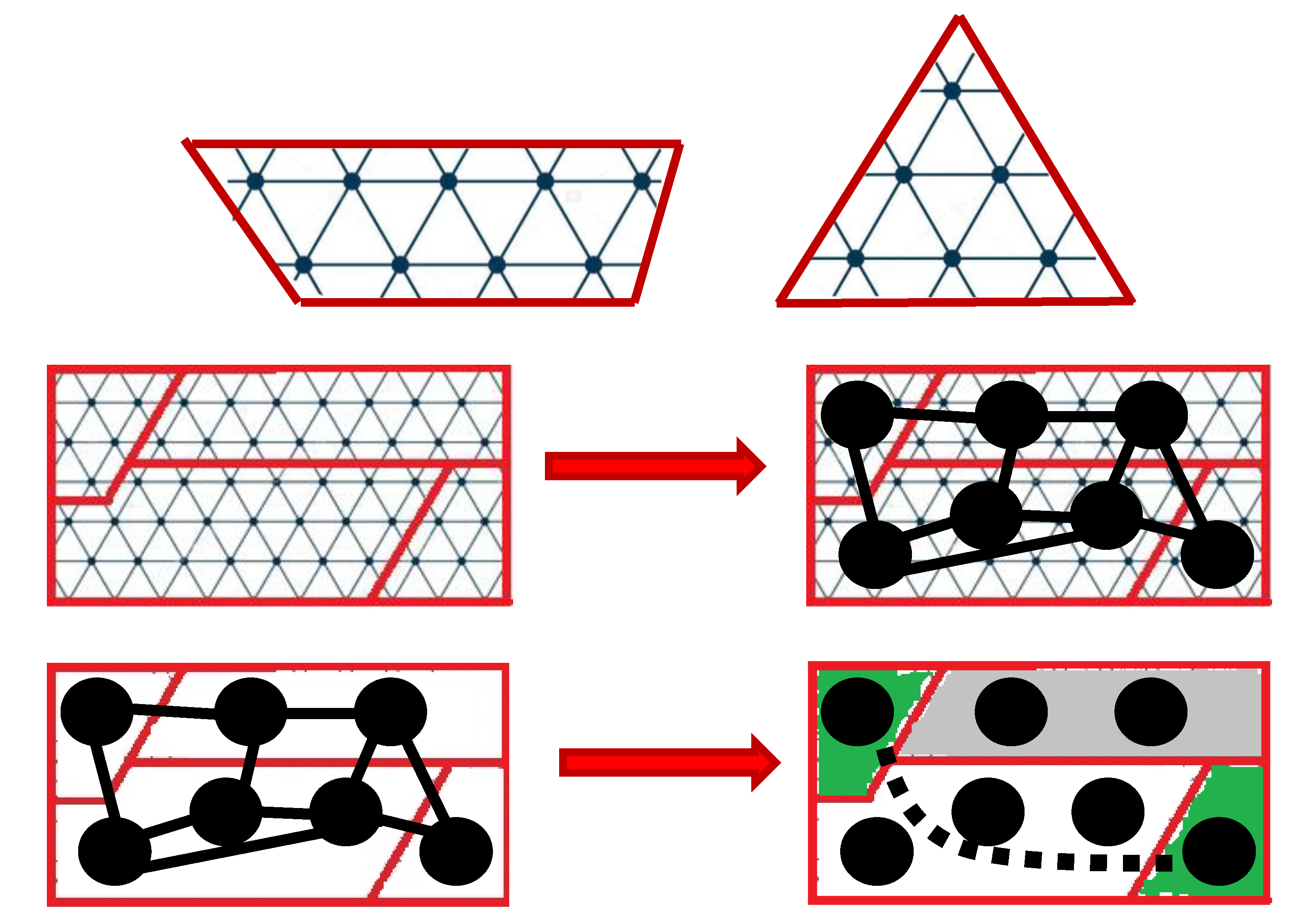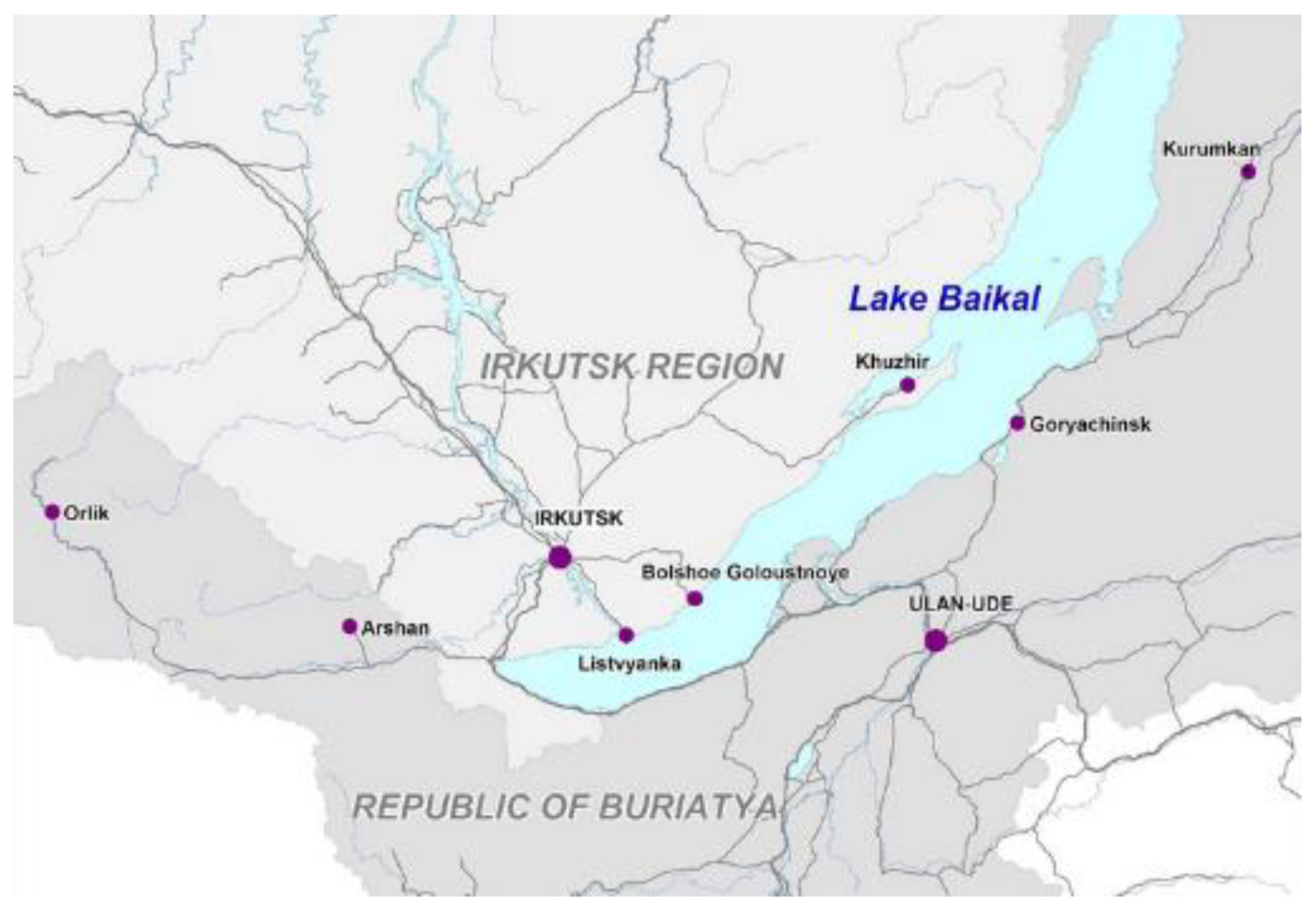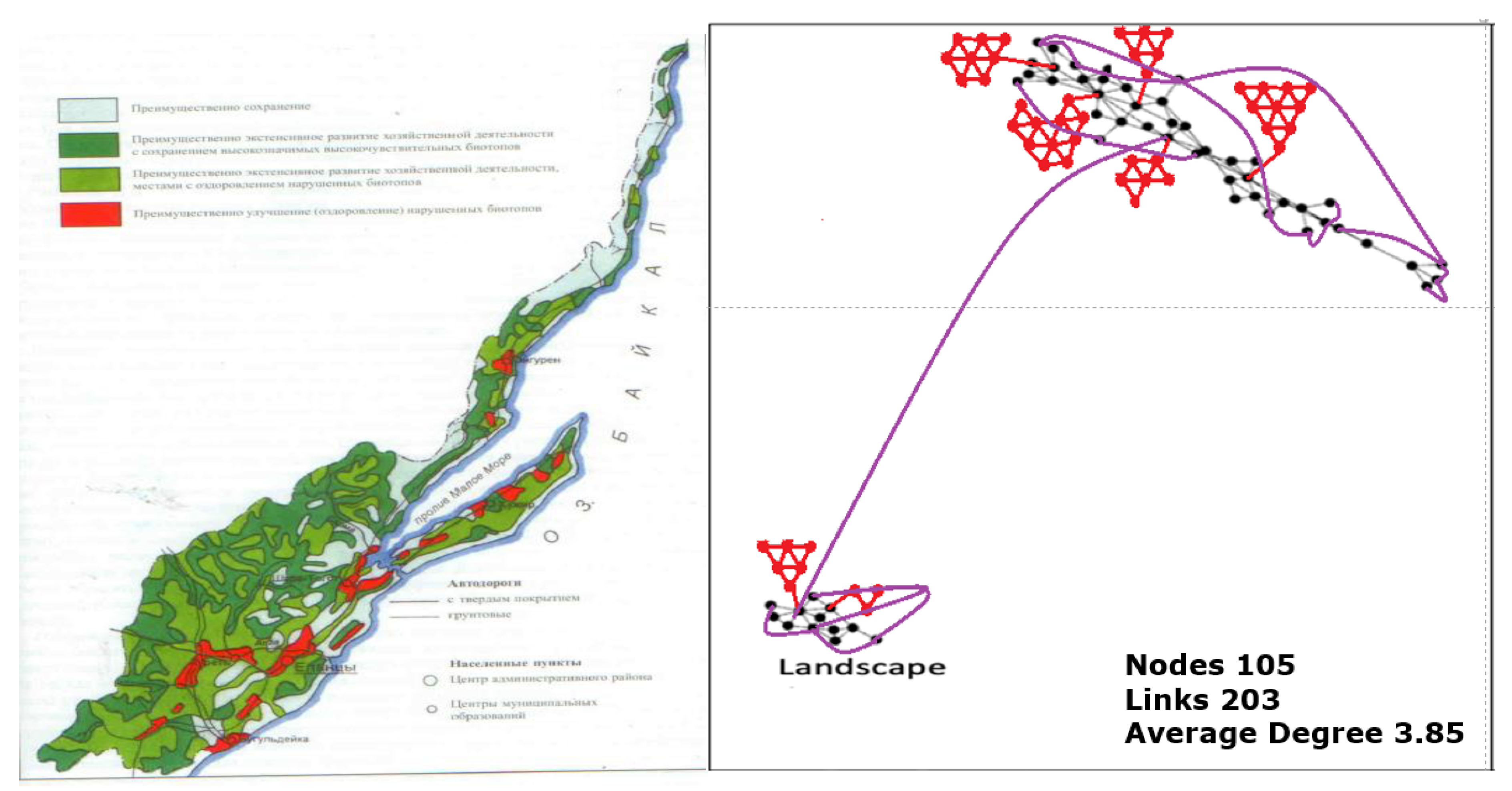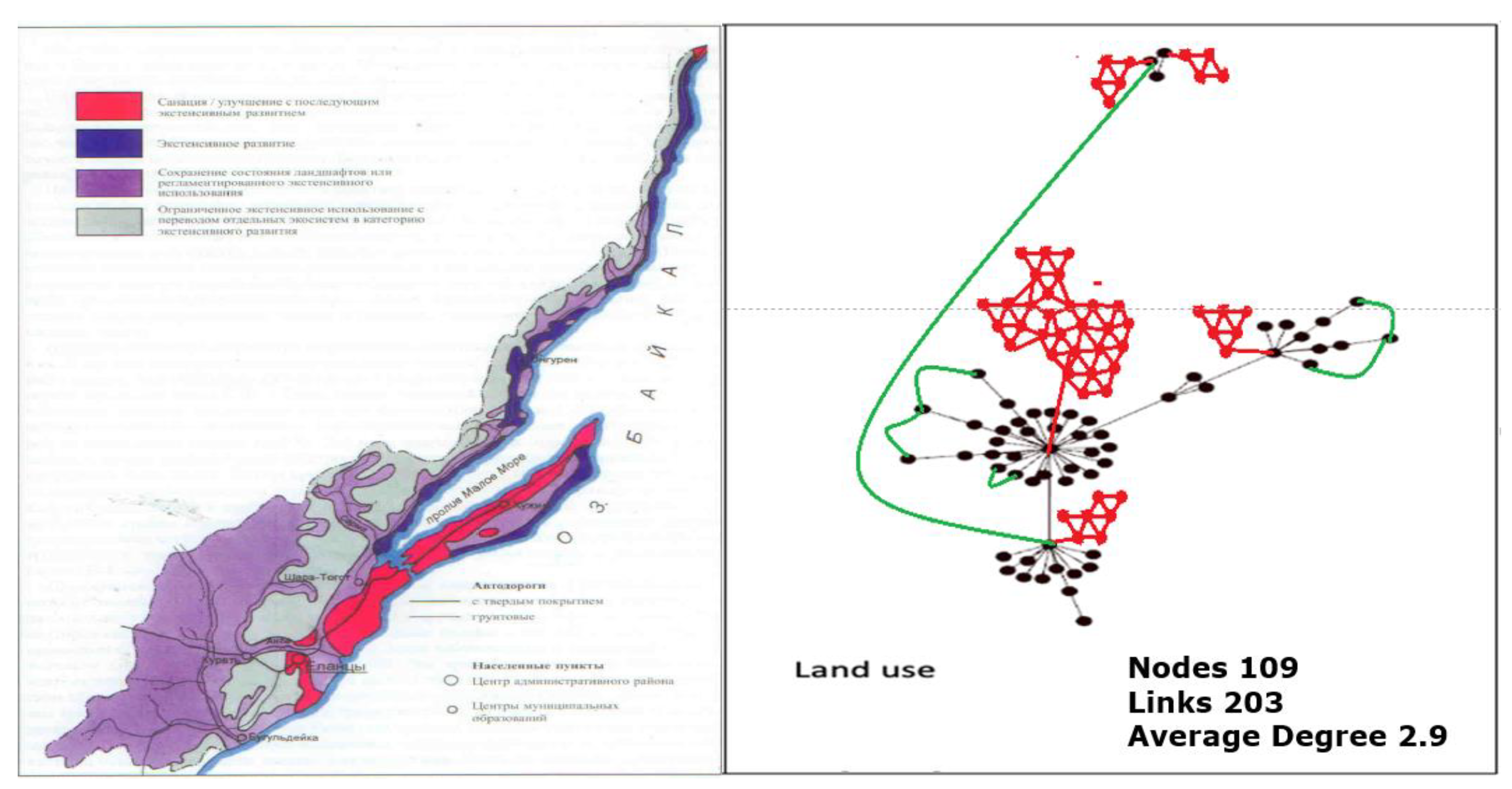Network Platform for Tourism Sector: Transformation and Interpretation of Multifaceted Data
Abstract
1. Introduction
2. Materials and Methods
3. Results
3.1. Baikal Natural Territory as Tourism Destination Analyzed through NLRTD
3.2. NURTD of the Baikal Natural Territory as a Tourism Destination
4. Discussion
5. Conclusions
Author Contributions
Funding
Conflicts of Interest
References
- Baggio, R. Studying complex tourism systems: A novel approach based on networks derived from a time series. arXiv 2013, arXiv:1302.5909. [Google Scholar]
- De Montis, A.; Chessa, A.; Campagna, M.; Caschili, S.; Deplano, G. Modeling commuting systems through a complex network analysis: A study of the Italian islands of Sardinia and Sicily. J. Transp. Land Use 2010, 2, 39–55. [Google Scholar] [CrossRef][Green Version]
- Lee, J.W.; Maeng, S.E.; Ha, G.-G.; Lee, M.H.; Cho, E.S. Applications of Complex Networks on Analysis of World Trade Network. J. Physics Conf. Ser. 2013, 410, 012063. [Google Scholar] [CrossRef]
- Semenov, A.; Mantzaris, A.V.; Nikolaev, A.; Veremyev, A.; Veijalainen, J.; Pasiliao, E.L.; Boginski, V. Exploring Social Media Network Landscape of Post-Soviet Space. IEEE Access 2018, 7, 411–426. [Google Scholar] [CrossRef]
- Gadek, G.; Pauchet, A.; Brunessaux, S.; Khelif, K.; Grilheres, B. AI techniques to analyse a social network on text, user and group level: Application on Galaxy2. In Proceedings of the 4ème Conférence sur les Applications Pratiques de L’Intelligence Artificielle (APIA2018), Nancy, France, 2–6 July 2018. [Google Scholar]
- Wu, Q.; Zhu, W. Toward a generalized theory of epidemic awareness in social networks. Int. J. Mod. Phys. C 2017, 28, 1750070. [Google Scholar] [CrossRef]
- Newman, M.E.J. The Structure and Function of Complex Networks. SIAM Rev. 2003, 45, 167–256. [Google Scholar] [CrossRef]
- Dirnberger, M.; Kehl, T.; Neumann, A. NEFI: Network Extraction from Images. Sci. Rep. 2015, 5, 15669. [Google Scholar] [CrossRef]
- Zaidi, F. Analysis, Structure and Organization of Complex Networks. Networking and Internet Architecture; Université Sciences et Technologies—Bordeaux I, 2010. Engish.tel-00542703; 152p. Available online: https://tel.archives-ouvertes.fr/tel-00542703/PDF/FarazZaidiThesis.pdf (accessed on 1 June 2020).
- Liu, X.F.; Tse, C.K. A General Framework for Complex Network Applications. arXiv 2015, arXiv:1507.05687. [Google Scholar]
- Zanin, M.; Sun, X.; Wandelt, S. Studying the Topology of Transportation Systems through Complex Networks: Handle with Care. J. Adv. Transp. 2018, 2018, 1–17. [Google Scholar] [CrossRef]
- Derrible, S.; Kennedy, C. Transportation Research Record. J. Transp. Res. Board 2009, 21, 17–25. [Google Scholar] [CrossRef]
- Tikhomirov, A.; Rossodivita, A.; Kinash, N.; Trufanov, A.; Berestneva, O. General topologic environment of the Russian railway network. J. Physics: Conf. Ser. 2017, 803, 12165. [Google Scholar] [CrossRef]
- Zhang, Z.; Xu, J.; Zhou, X. Mapping time series into complex networks based on equal probability division. AIP Adv. 2019, 9, 015017. [Google Scholar] [CrossRef]
- Lacasa, L.; Luque, B.; Luque, J.; Nuno, J.C. The visibility graph: A new method for estimating the Hurst exponent of fractional Brownian motion. arXiv 2009, arXiv:0901.0888. [Google Scholar] [CrossRef]
- Lacasa, L.; Nicosia, V.; Latora, V. Network structure of multivariate time series. Sci. Rep. 2015, 5, 15508. [Google Scholar] [CrossRef]
- Baggio, R. The science of complexity in the tourism domain: A perspective article. Tour. Rev. 2019, 75, 16–19. [Google Scholar] [CrossRef]
- Baggio, R.; Sainaghi, R. Complex and chaotic tourism systems: Towards a quantitative approach. Int. J. Contemp. Hosp. Manag. 2011, 23, 840–861. [Google Scholar] [CrossRef]
- Olmedo, E.; Mateos, R. Quantitative characterization of chaordic tourist destination. Tour. Manag. 2015, 47, 115–126. [Google Scholar] [CrossRef]
- Po, W.-C.; Huang, B.-N. Tourism development and economic growth—A nonlinear approach. Phys. A Stat. Mech. Its Appl. 2008, 387, 5535–5542. [Google Scholar] [CrossRef]
- Cole, S. A logistic tourism model: Resort cycles, globalization, and chaos. Ann. Tour. Res. 2009, 36, 689–714. [Google Scholar] [CrossRef]
- Provenzano, D. Power laws and the market structure of tourism industry. Empir. Econ. 2013, 47, 1055–1066. [Google Scholar] [CrossRef]
- Ulubasoglu, M.A.; Hazari, B.R. Zipf’s law strikes again: The case of tourism. J. Econ. Geogr. 2004, 4, 459–472. [Google Scholar] [CrossRef]
- Pizzitutti, F.; Mena, C.F.; Walsh, S. Modelling Tourism in the Galapagos Islands: An Agent-Based Model Approach. J. Artif. Soc. Soc. Simul. 2014, 17, 14. [Google Scholar] [CrossRef]
- Raisi, H.; Baggio, R.; Barratt-Pugh, L.; Willson, G. A network perspective of knowledge transfer in tourism. Ann. Tour. Res. 2020, 80, 102817. [Google Scholar] [CrossRef]
- Baggio, R.; Scott, N.; Cooper, C. Network science—A review focused on tourism. Ann. Tour. Res. 2010, 37, 802–827. [Google Scholar] [CrossRef]
- Del Chiappa, G.; Presenza, A. The use of Network Analysis to Assess Relationships Among Stakeholders Within a Tourism Destination: An Empirical Investigation on Costa Smeralda-gallura, Italy. Tour. Anal. 2013, 18, 1–13. [Google Scholar] [CrossRef]
- Scott, N.; Cooper, C.; Baggio, R. Destination networks—Four Australian cases. Ann. Tour. Res. 2008, 35, 169–188. [Google Scholar] [CrossRef]
- Sainaghi, R.; Baggio, R. Structural social capital and hotel performance: Is there a link? Int. J. Hosp. Manag. 2014, 37, 99–110. [Google Scholar] [CrossRef]
- Grama, C.-N.; Baggio, R. A network analysis of Sibiu County, Romania. Ann. Tour. Res. 2014, 47, 89–93. [Google Scholar] [CrossRef]
- Miguéns, J.; Mendes, J.F.F. Travel and tourism: Into a complex network. Phys. A Stat. Mech. Its Appl. 2008, 387, 2963–2971. [Google Scholar] [CrossRef]
- Creaco, S.; Querini, G. The Role of Tourism in Sustainable Economic Development. In Proceedings of the 43rd Congress of the European Regional Science Association, Jyväskylä, Finland, 27–30 August 2003; 17p. Available online: https://www.econstor.eu/bitstream/10419/115956/1/ERSA2003_084.pdf (accessed on 1 June 2020).
- Meyer, D.F.; Meyer, N. The role and impact of tourism on local economic development: A comparative study. Afr. J. Phys. Health Educ. Recreat. Danc. 2015, 21, 197–214. [Google Scholar] [CrossRef]
- Kiper, T. Role of Ecotourism in Sustainable Development. In Advances in Landscape Architecture; InTech: Rijeka, Croatia, 2013; pp. 773–802. [Google Scholar] [CrossRef]
- Guri, A. The role of sustainable tourism in the economic development of Vlora district. Eur. J. Res. Reflect. Manag. Sci. 2016, 4, 53–62. [Google Scholar]
- Manzoor, F.; Wei, L.; Asif, A.H.M.; Haq, M.Z.U.; Rehman, H.U. The Contribution of Sustainable Tourism toEconomic Growth and Employment in Pakistan. Int. J. Environ. Res. Public Heal. 2019, 16, 3785. [Google Scholar] [CrossRef]
- Kreishan, F.M. Time series evidence for tourism led-growth hypothesis: A case study of Jordan. Int. Manag. Rev. 2011, 7, 89–93. [Google Scholar]
- Akan, Y.; Arslan, I.; Isık, U.C. The Impact of Tourism on Economic Growth: The Case of Turkey. J. Tour. 2008, 9, 47–69. [Google Scholar]
- Kozhokulov, S.; Chen, X.; Yang, D.; Issanova, G.; Samarkhanov, K.; Aliyeva, S. Assessment of Tourism Impact on the Socio-Economic Spheres of the Issyk-Kul Region (Kyrgyzstan). Sustainability 2019, 11, 3886. [Google Scholar] [CrossRef]
- Morozov, M.A.; Rubtsova, N.V. Tourism’s Role in Sustainable Socio-Economic Development of the Regions of the Siberian Federal District. Reg. Econ. Theory Pract. 2016, 8, 187–198. Available online: https://cyberleninka.ru/article/n/rol-turizma-v-ustoychivom-sotsialno-ekonomicheskom-razvitii-regionov-sibirskogo-federalnogo-okruga/viewer (accessed on 1 June 2020).
- Danilenko, N.N.; Rubtsova, N.V. Impact of Social Functions of Tourism on Region’s Sustainable Development (by the Example of Baikal Region). Izvestiya Baikal’skogogosudarstvennogouniversiteta (Bull. Baikal State Univ.) 2012, 6, 48–53. Available online: http://izvestia.bgu.ru/reader/article.aspx?id=15892 (accessed on 1 June 2020).
- Rubtsova, N.V. The Impact of Sustainable Development of Recreation and Tourism on Sustainable Development of the Region (an Empirical Study on the Example of the Baikal Region). Izv. Irkutsk State Econ. Acad. 2014, 5, 47–60. Available online: http://izvestia.bgu.ru/reader/article.aspx?id=19779 (accessed on 1 June 2020).
- Sun, X.; Small, M.; Zhao, Y.; Xue, X. Characterizing system dynamics with a weighted and directed network constructed from time series data. Chaos: Interdiscip. J. Nonlinear Sci. 2014, 24, 24402. [Google Scholar] [CrossRef]
- Hassan, M.K.; Pavel, N.I.; Hassan, M.Z. Scale-free network topology and multifractality in a weighted planar stochastic lattice. New J. Phys. 2010, 12, 93045. [Google Scholar] [CrossRef]
- Iacovacci, J.; Lacasa, L. Visibility graphs for image processing. arXiv 2018, arXiv:1804.07125. [Google Scholar] [CrossRef]
- Hina, O.; Rossodivita, A.; Tikhomirov, A.; Trufanov, A. Networkalization of Network–Unlike Entities: How to Preserve Encoded Information. Creat. Intell. Technol. Data Sci. 2019, 143–151. [Google Scholar]
- Gephi—The Open Graph VizPlatform. Available online: https://github.com/gephi/gephi (accessed on 1 June 2020).
- Neo4j. Available online: https://github.com/neo4j/neo4j (accessed on 1 June 2020).
- Khor, S. Generating Hierarchically Modular Networks via Link Switching. arXiv 2009, arXiv:0903.2598. Available online: https://ui.adsabs.harvard.edu/abs/2009arXiv0903.2598K/abstract (accessed on 1 June 2020).
- The Number of Tourists Who Visited the Island of Olkhon on Lake Baikal during the Year. Available online: https://ria.ru/20200123/1563764497.html (accessed on 1 June 2020).
- Digitization Gartner Glossary. Available online: https://www.gartner.com/en/information-technology/glossary/digitization (accessed on 1 June 2020).
- Digitalization Gartner Glossary. Available online: https://www.gartner.com/en/information-technology/glossary/digitalization (accessed on 1 June 2020).
- Kivela, M.; Arenas, A.; Barthelemy, M.; Gleeson, J.P.; Moreno, Y.; Porter, M. A Multilayer networks. J. Complex Netw. 2014, 2, 203–271. [Google Scholar] [CrossRef]
- Urazova, N.; Kuklina, M.; Kotelnikov, N.; Kaymonova, O.; Trufanov, A. Application of the Theory of Complex Networks in Analysis of Tourist Infrastructure. In Proceedings of the Internation Conference on “Humanities and Social Sciences: Novations, Problems, Prospects” (HSSNPP 2019), Novosibirsk, Russia, 5–6 March 2019; pp. 720–724. [Google Scholar] [CrossRef][Green Version]
- Hanteer, O.; Interdonato, R.; Magnani, M.; Tagarelli, A.; Rossi, L. Community Detection in Multiplex Networks. arXiv 2019, arXiv:1910.07646. [Google Scholar]
- Khovavko, I.Y. On the Problems of the Baikal Region in the Context of Modern Russian Environmental Policy. E-journal. Public Adm. 2018, 69, 358–380. Available online: http://e-journal.spa.msu.ru/uploads/vestnik/2018/vipusk__69._avgust_2018_g./ekonomika_prirodopolzovanija/khovavko.pdf (accessed on 1 June 2020).
- Cherevichko, T. Tourism as a System: Methodology of Research. Concept 2015, 7, 7. Available online: http://e-kon-cept.ru/2015/15224.htm (accessed on 1 June 2020).
- Kinash, N.; Tikhomirov, A.; Trufanov, A.; Berestneva, O.; Boukhanovsky, A.; Ashurova, Z. Analysis of Large-Scale Networks Using High Performance Technology (Vkontakte Case Study). Creat. Intell. Technol. Data Sci. 2015, 535, 531–541. [Google Scholar] [CrossRef]
- Ashurova, Z.; Tikhomirov, A.; Trufanov, A.; Kinash, N.; Berestneva, O.; Rossodivita, A. Network platform of program governance for E-health service. In Proceedings of the 2017 12th International Scientific and Technical Conference on Computer Sciences and Information Technologies (CSIT), Lviv, Ukraine, 5–8 September 2017; pp. 71–74. [Google Scholar] [CrossRef]
- Glotin, H.; Poupard, M.; Marxer, R.; Ferrari, M.; Ricard, J.; Roger, V.; Patris, J.; Malige, F.; Giraudet, P.; Prevot, J.-M.; et al. Big Data Passive Acoustic for Baikal Lake Soundscape & Ecosystem Observatory. In Russian-French Workshop in Big Data and Applications, Russia, Moscow, 12–13 October 2017; HSE Publishing House: Moscow, Russia, 2018; pp. 21–44. Available online: https://www.hse.ru/data/2018/10/04/1157264869/Proceedings_Russian_French_Workshop.pdf (accessed on 1 June 2020).
- Roberts, S.L.; Swann, G.E.A.; McGowan, S.; Panizzo, V.; Vologina, E.G.; Sturm, M.; Mackay, A.W. Diatom evidence of 20th century ecosystem change in Lake Baikal, Siberia. PLoS ONE 2018, 13, e0208765. [Google Scholar] [CrossRef]
- Galindo, F.; Dmitrienko, N.V.; Caruso, A.; Rossodivita, A.; Tikhomirov, A.A.; Trufanov, A.I.; Shubnikov, E.V. Modeling of Aggregate Attacks on Complex Networks. Inf. Secur. Technol. Mosc. N 2010, 3, 115–121. [Google Scholar]






| No. p/p | Metric | Value |
|---|---|---|
| 1 | nodes | 81 |
| 2 | links | 80 |
| 3 | average degree | 1975 |
| 4 | diameter | 8 |
| 5 | radius | 4 |
| 6 | average path length | 5.23 |
| 7 | density | 0.025 |
| 8 | modularity | 0.717 |
| 9 | number of communities | 9 |
| 10 | number of weakly connected components | 1 |
| 11 | average clustering coefficient | 0.000 |
| Problems | Owners of Tourist Hostels (n = 5) | “Tabletka” Drivers (n = 5) | Locals (n = 4) | Government Official (n = 2) | Community Leaders (n = 3) | Quotes from Respondents |
|---|---|---|---|---|---|---|
| Liquid household waste | 5 | 0 | 3 | 2 | 3 | “… take all the waste the guys out as you want. How to take out when there is no ice and the ice is bad?” “Well, there were scandals when the violators were caught. In winter, somewhere when you can’t go cross Baikal …” |
| Relationship with the national park | 4 | 4 | 3 | 1 | 3 | “… First of all, it is the relationship with the national park because the laws are not perfect. That don’t protect us at all” “The National Park prohibits everything. There is no alternative” |
| Fishing restrictions | 3 | 3 | 2 | 0 | 2 | “They caught fish without control by seine, net, etc., And there is no fish for today. The plant is closed” “There used to be fishing, someone was fishing, but now it’s banned, and the fish doesn’t come in either …” |
© 2020 by the authors. Licensee MDPI, Basel, Switzerland. This article is an open access article distributed under the terms and conditions of the Creative Commons Attribution (CC BY) license (http://creativecommons.org/licenses/by/4.0/).
Share and Cite
Kuklina, M.; Trufanov, A.; Bayaskalanova, T.; Urazova, N.; Tikhomirov, A.; Berestneva, O.; Marukhina, O.; Vidyaev, I.; Fisochenko, O.; Lyzin, I.; et al. Network Platform for Tourism Sector: Transformation and Interpretation of Multifaceted Data. Sustainability 2020, 12, 6314. https://doi.org/10.3390/su12166314
Kuklina M, Trufanov A, Bayaskalanova T, Urazova N, Tikhomirov A, Berestneva O, Marukhina O, Vidyaev I, Fisochenko O, Lyzin I, et al. Network Platform for Tourism Sector: Transformation and Interpretation of Multifaceted Data. Sustainability. 2020; 12(16):6314. https://doi.org/10.3390/su12166314
Chicago/Turabian StyleKuklina, Maria, Andrey Trufanov, Tuyana Bayaskalanova, Nina Urazova, Alexei Tikhomirov, Olga Berestneva, Olga Marukhina, Igor Vidyaev, Oksana Fisochenko, Ivan Lyzin, and et al. 2020. "Network Platform for Tourism Sector: Transformation and Interpretation of Multifaceted Data" Sustainability 12, no. 16: 6314. https://doi.org/10.3390/su12166314
APA StyleKuklina, M., Trufanov, A., Bayaskalanova, T., Urazova, N., Tikhomirov, A., Berestneva, O., Marukhina, O., Vidyaev, I., Fisochenko, O., Lyzin, I., Berestneva, E., & Hoch, N. (2020). Network Platform for Tourism Sector: Transformation and Interpretation of Multifaceted Data. Sustainability, 12(16), 6314. https://doi.org/10.3390/su12166314





